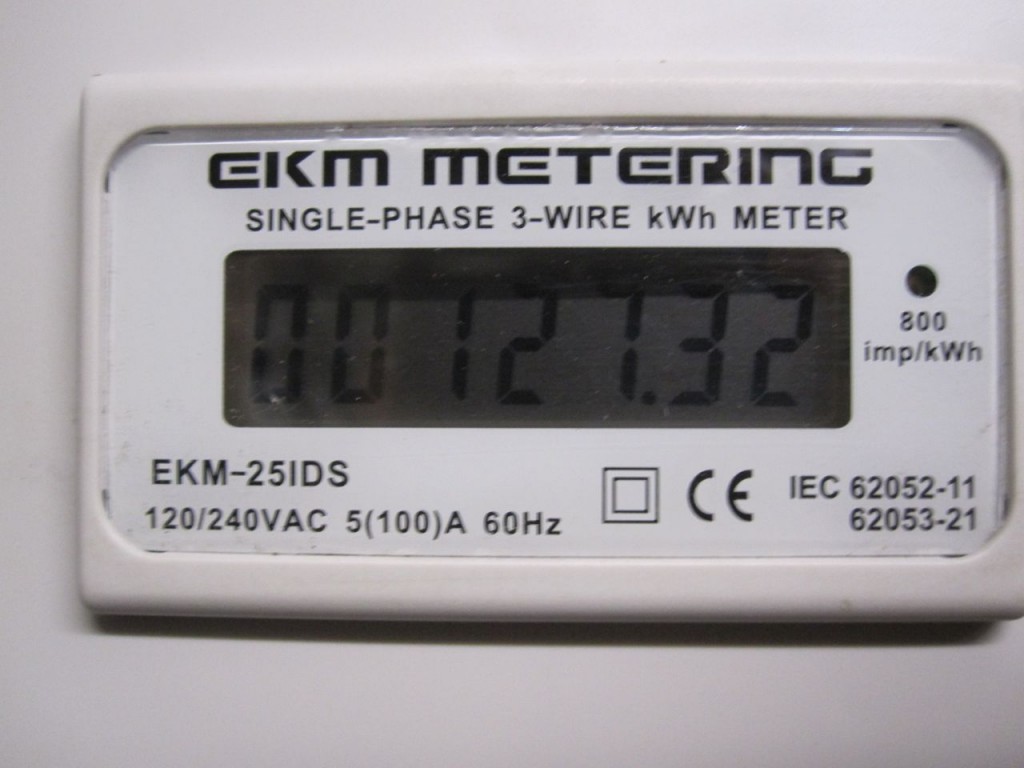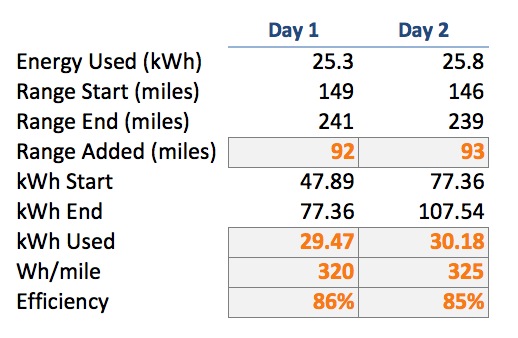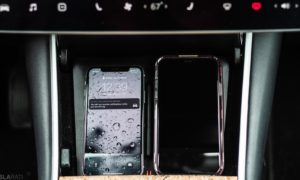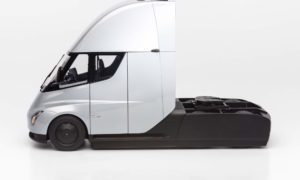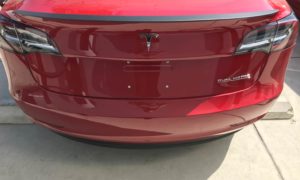Lifestyle
EKM Digital Submeter Measures EV Charging Efficiency
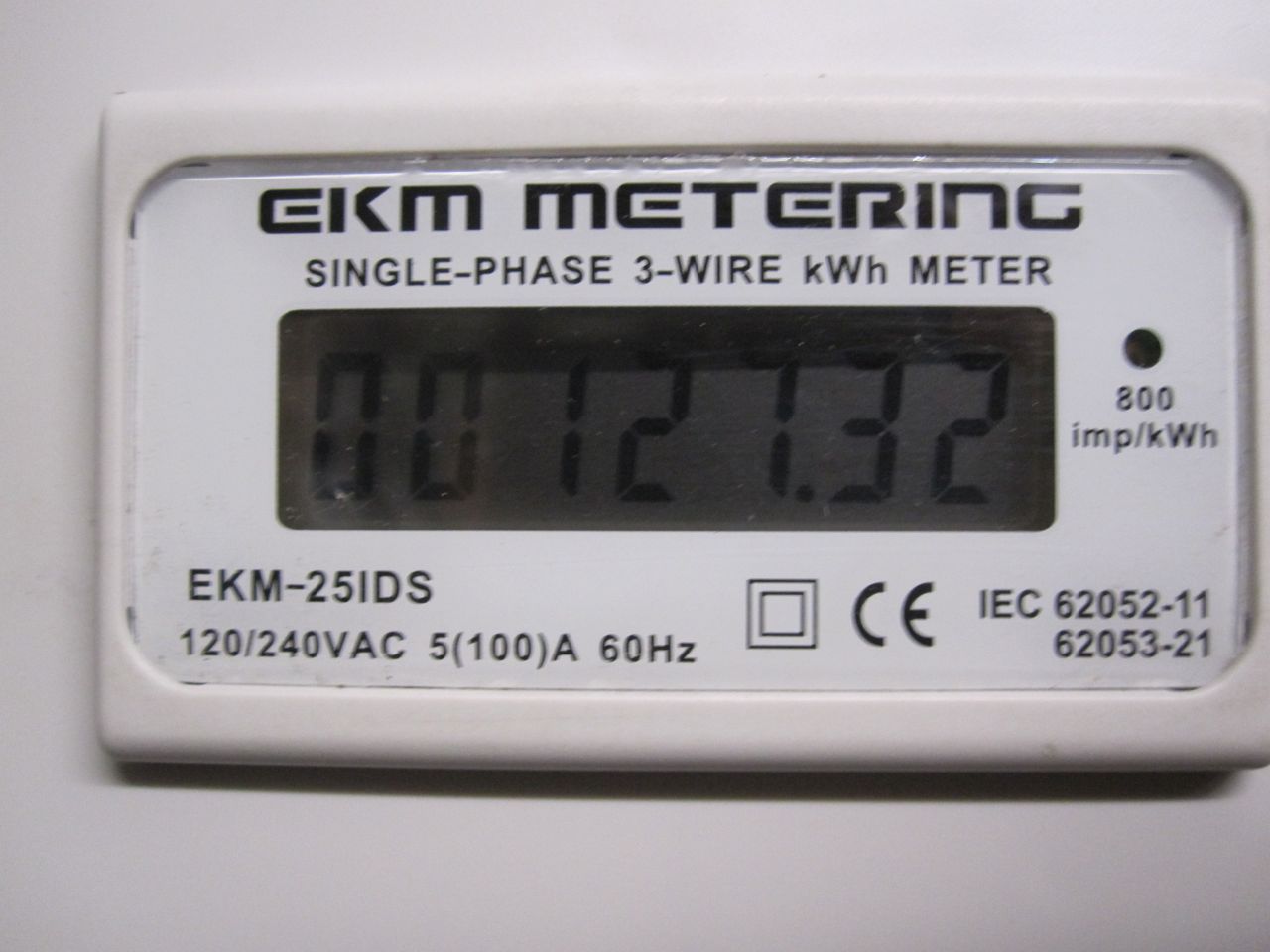
Electric vehicle owners may now know that 10-12% of drawn electricity is lost during the charging process when AC is converted to DC.
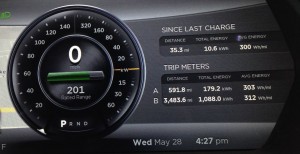 The “Since Last Charge” indicator on the Tesla Model S driver’s console keeps count of distance, energy used and average energy used per mile since the last time you unplugged, but matching this energy consumption to what you’re being billed by your company is more difficult than one might think.
The “Since Last Charge” indicator on the Tesla Model S driver’s console keeps count of distance, energy used and average energy used per mile since the last time you unplugged, but matching this energy consumption to what you’re being billed by your company is more difficult than one might think.
Taking the 10.6kWh Total Energy readout from the dash and multiplying it by my billable electricity rate of $0.1670/kWh, I would think that it costs me $1.77 to drive 35.3 miles. However the actual costs are slightly higher because of the power conversion losses when charging. Charging via a standard 110V wall plug in the US is reported to be much less efficient than a NEMA 14-50 hence you’ll be using even more energy to reach the same state of charge.
Tesla’s charging calculator appears to take into account some of these charging loses. According to the calculator, 35 miles of range added to the Model S requires 11.6kWh of energy although I was able to achieve that with through 10.6 kWh as seen through my dash readout. This could imply a 91% charge efficiency but of course this is a very loose calculation and based on many assumptions such as the speed in which you drive, elevation changes and weather. It’s not simple to calculate how much actual energy you’re using to charge your Tesla Model S.
The EKM Digital Submeter
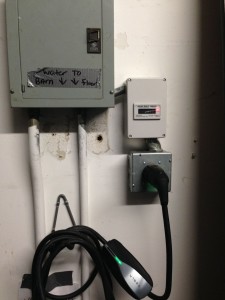 The solution I found was to put a submeter between the EV charge outlet and main power supply. There are many types of meters on the market from basic kWh counters to advanced meters that can broadcast actual use over a wifi network, plot graphs, etc. After doing some extensive research, I decided to go with a metering solution from EKM Metering. My electrician did some independent research and came up with the same brand so I felt pretty good about my choice. I ended up purchasing the 100A kWh EKM digital submeter and enclosure.
The solution I found was to put a submeter between the EV charge outlet and main power supply. There are many types of meters on the market from basic kWh counters to advanced meters that can broadcast actual use over a wifi network, plot graphs, etc. After doing some extensive research, I decided to go with a metering solution from EKM Metering. My electrician did some independent research and came up with the same brand so I felt pretty good about my choice. I ended up purchasing the 100A kWh EKM digital submeter and enclosure.
My electrician was able to complete the installation in 3 hours with a portion of the time spent on retrofitting the EKM enclosure to accommodate for the larger 240v conduit. Total cost spent for products, labor and materials was $292.
How Does it Work?
The EKM submeter is like an odometer but with an energy readout that continuously increments as power is being drawn. There is no reset button. A blinking red light indicates that 1.25Wh is drawn per single blink of the LED.
Measuring actual energy consumed over a specific time period requires taking some notes. Here are the the measurements and results of my tests:
My results indicate that there’s approximately a 85% charging efficiency for my Tesla Model S which is less than the 91% efficiency that Tesla Motors seems to be using in their online calculator.
I’ll be performing several more tests over a longer period of time. I want to look at power draw differences while the Model S is asleep and also analyze variations in energy consumption due to software updates.
Conclusion
Overall the EKM Digital Submeter is a nice addition to any EV charging setup if you’re looking for a true picture of how much energy usage is going into your Tesla Model S / electrical vehicle. Assuming a $0.167/kWh electricity cost and 325 Wh/mile, the cost of the meter plus installation would require 5,380 miles of EV driving to break even.
If you’re looking for a cheaper alternative, simply add 15% to the energy usage readout on your EV to approximate the true energy cost per EV mile driven. Drive clean and drive smart!
Elon Musk
X account with 184 followers inadvertently saves US space program amid Musk-Trump row
Needless to say, the X user has far more than 184 followers today after his level-headed feat.

An X user with 184 followers has become the unlikely hero of the United States’ space program by effectively de-escalating a row between SpaceX CEO Elon Musk and President Donald Trump on social media.
Needless to say, the X user has far more than 184 followers today after his level-headed feat.
A Near Fall
During Elon Musk and Donald Trump’s fallout last week, the U.S. President stated in a post on Truth Social that a good way for the United States government to save money would be to terminate subsidies and contracts from the CEO’s companies. Musk responded to Trump’s post by stating that SpaceX will start decommissioning its Dragon spacecraft immediately.
Musk’s comment was received with shock among the space community, partly because the U.S. space program is currently reliant on SpaceX to send supplies and astronauts to the International Space Station (ISS). Without Dragon, the United States will likely have to utilize Russia’s Soyuz for the same services—at a significantly higher price.
X User to the Rescue
It was evident among X users that Musk’s comments about Dragon being decommissioned were posted while emotions were high. It was then no surprise that an X account with 184 followers, @Fab25june, commented on Musk’s post, urging the CEO to rethink his decision. “This is a shame this back and forth. You are both better than this. Cool off and take a step back for a couple days,” the X user wrote in a reply.
Much to the social media platform’s surprise, Musk responded to the user. Even more surprising, the CEO stated that SpaceX would not be decommissioning Dragon after all. “Good advice. Ok, we won’t decommission Dragon,” Musk wrote in a post on X.
Not Planned, But Welcomed
The X user’s comment and Musk’s response were received extremely well by social media users, many of whom noted that @Fab25june’s X comment effectively saved the U.S. space program. In a follow-up comment, the X user, who has over 9,100 followers as of writing, stated that he did not really plan on being a mediator between Musk and Trump.
“Elon Musk replied to me. Somehow, I became the accidental peace broker between two billionaires. I didn’t plan this. I was just being me. Two great minds can do wonders. Sometimes, all it takes is a breather. Grateful for every like, DM, and new follow. Life’s weird. The internet’s weirder. Let’s ride. (Manifesting peace… and maybe a Model Y.)” the X user wrote.
Lifestyle
Tesla Cybertruck takes a bump from epic failing Dodge Charger
The Cybertruck seemed unharmed by the charging Charger.

There comes a time in a driver’s life when one is faced with one’s limitations. For the driver of a Dodge Charger, this time came when he lost control and crashed into a Tesla Cybertruck–an absolute epic fail.
A video of the rather unfortunate incident was shared on the r/TeslaLounge subreddit.
Charging Charger Fails
As could be seen in the video, which was posted on the subreddit by Model Y owner u/Hammer_of_something, a group of teens in a Dodge Charger decided to do some burnouts at a Tesla Supercharger. Unfortunately, the driver of the Charger failed in his burnout or donut attempt, resulting in the mopar sedan going over a curb and bumping a charging Cybertruck.
Ironically, the Dodge Charger seemed to have been parked at a Supercharger stall before its driver decided to perform the failed stunt. This suggests that the vehicle was likely ICE-ing a charging stall before it had its epic fail moment. Amusingly enough, the subreddit member noted that the Cybertruck did not seem like it took any damage at all despite its bump. The Charger, however, seemed like it ran into some trouble after crashing into the truck.
Alleged Aftermath
As per the the r/TeslaLounge subreddit member, the Cybertruck owner came rushing out to his vehicle after the Dodge Charger crashed into it. The Model Y owner then sent over the full video of the incident, which clearly showed the Charger attempting a burnout, failing, and bumping into the Cybertruck. The Cybertruck owner likely appreciated the video, in part because it showed the driver of the Dodge Charger absolutely freaking out after the incident.
The Cybertruck is not an impregnable vehicle, but it can take bumps pretty well thanks to its thick stainless steel body. Based on this video, it appears that the Cybertruck can even take bumps from a charging Charger, all while chilling and charging at a Supercharger. As for the teens in the Dodge, they likely had to provide a long explanation to authorities after the incident, since the cops were called to the location.
Lifestyle
Anti-Elon Musk group crushes Tesla Model 3 with Sherman tank–with unexpected results
Ironically enough, the group’s video ended up highlighting something very positive for Tesla.

Anti-Elon Musk protesters and critics tend to show their disdain for the CEO in various ways, but a recent video from political action group Led By Donkeys definitely takes the cake when it comes to creativity.
Ironially enough, the group’s video also ended up highlighting something very positive for Tesla.
Tank vs. Tesla
In its video, Led By Donkeys featured Ken Turner, a 98-year-old veteran who served in the British army during World War II. The veteran stated that Elon Musk, the richest man in the world, is “using his immense power to support the far-right in Europe, and his money comes from Tesla cars.”
He also noted that he had a message for the Tesla CEO: “We’ve crushed fascism before and we’ll crush it again.” To emphasize his point, the veteran proceeded to drive a Sherman tank over a blue Tesla Model 3 sedan, which, of course, had a plate that read “Fascism.”
The heavy tank crushed the Model 3’s glass roof and windows, much to the delight of Led By Donkeys’ commenters on its official YouTube channel. But at the end of it all, the aftermath of the anti-Elon Musk demonstration ended up showcasing something positive for the electric vehicle maker.
Tesla Model 3 Tanks the Tank?
As could be seen from the wreckage of the Tesla Model 3 after its Sherman encounter, only the glass roof and windows of the all-electric sedan were crushed. Looking at the wreckage of the Model 3, it seemed like its doors could still be opened, and everything on its lower section looked intact.
Considering that a standard M4 Sherman weighs about 66,800 to 84,000 pounds, the Model 3 actually weathered the tank’s assault really well. Granted, the vehicle’s suspension height before the political action group’s demonstration suggests that the Model 3’s high voltage battery had been removed beforehand. But even if it hadn’t been taken off, it seemed like the vehicle’s battery would have survived the heavy ordeal without much incident.
This was highlighted in comments from users on social media platform X, many of whom noted that a person in the Model 3 could very well have survived the ordeal with the Sherman. And that, ultimately, just speaks to the safety of Tesla’s vehicles. There is a reason why Teslas consistently rank among the safest cars on the road, after all.
-

 Elon Musk1 day ago
Elon Musk1 day agoTesla investors will be shocked by Jim Cramer’s latest assessment
-

 News6 days ago
News6 days agoTesla Robotaxi’s biggest challenge seems to be this one thing
-

 News2 weeks ago
News2 weeks agoTesla’s Grok integration will be more realistic with this cool feature
-

 Elon Musk2 weeks ago
Elon Musk2 weeks agoElon Musk slams Bloomberg’s shocking xAI cash burn claims
-

 News2 weeks ago
News2 weeks agoTesla China roars back with highest vehicle registrations this Q2 so far
-

 News2 weeks ago
News2 weeks agoTexas lawmakers urge Tesla to delay Austin robotaxi launch to September
-

 News2 weeks ago
News2 weeks agoTesla dominates Cars.com’s Made in America Index with clean sweep
-

 Elon Musk1 week ago
Elon Musk1 week agoFirst Look at Tesla’s Robotaxi App: features, design, and more

